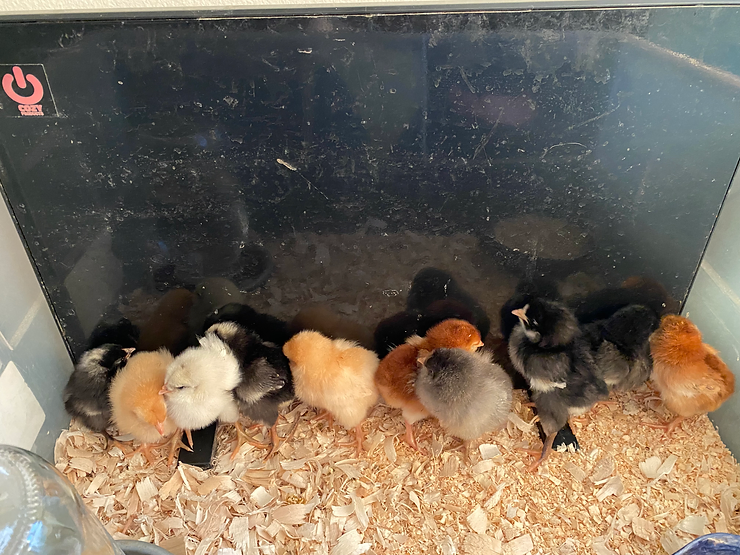Baby Chickens take love and care. You may wonder if it’s worth raising chickens from a day old or just getting them already grown. I will say that brooding your chicks will be some work, but having chickens that know you far outweigh the cons of brooding chickens.
Setting Up Your Brooder
- Your brooder can be big or small, depending on how many chickens you have. Remember that they get large, and you do not want to put them outside until they are fully feathered. We use a plastic tub for a little bit, and then when they can be outside with heat, we move them to our coop, which has an area for a brooder. If you keep them in a brooder until they are fully feathered, I suggest a galvanized stock tank and lots of space.
- Heater. We use this heater, and we’ve found that it helps feather out quicker. I like that it’s no-frills, and the chickens get to choose how far away from it they are at all times and how warm they stay. There is also no fire hazard.
- Food. I have always used non-medicated. I don’t have a preference. I just haven’t seen the need to use medicated feed. Feed them chick-starter crumbled feed until they start laying. Always get crumble for when they are little – I honestly don’t think they give you a choice with pellets. I keep food when they are little in a smaller feeder, then when they go to the bigger brooder, I put a long dish in that protects it from getting pooped or stepped in. Food Dish.
- Water. Keep it clean and fresh. Even baby chickens scratch around in their brooder, filling the water dish with pine shavings. We use the water bases that attach to a canning jar. I find them easy to store and simple to wash. Water Dish. When they get bigger, and there is more space, I get a bigger water dish. Bigger Water Dish.
- Bedding. We use pine shavings, or you can use pine shavings put into pellets. Either is great; it just gets down to preference. We now use hemp in our chicken coop, so I would probably use pellets or hemp. Both provide less dust!

Remember to keep it clean and ensure fresh food and water are filled. The radiated heat can be felt on the other side of the brooder. Your chickens are too cold if they are against the heater or under the heat lamp. Make sure they are located where there are no drafts. If they are roaming around, going to get food or water, or coming back to the heat source, it’s a perfect temperature. If they are avoiding the heat source at all costs, it’s too hot.
When your brooder starts to smell, add more of your preferred bedding on top of the dirty bedding. This saves time and starts a good deep litter system.
Baby Chickens tend to get a thing called pasty butt. Pasty butt can kill a baby chicken which is why it is so important to check their butts and wash off the poop that is stuck. If this goes too long and does not get cleaned, their vent can become blocked, leading to death. This is rare, but it can happen. Always be diligent with checking your chicks’ bums. Read more about how to care for pasty butt here.
Tips for Raising Friendly Chickens
- Get notoriously friendly breeds! Read my blog post about our favorite family-friendly breeds!
- Get breeds that lay well. 250 eggs or more a year!
- Hold them – All the time. If you have littles, let them enjoy holding the little babes.
- Start talking to them. I call mine “girls.” When I go outside, I say, “Hey girls!” and they come running.
- Name them. This might seem funny, but all the chickens I regularly hold have names.
Enjoy your time with your baby chicks! They are SO cute, and their little cheeps are so sweet. They grow quickly, and pretty soon, you will have your own farm-fresh eggs. Have fun!

